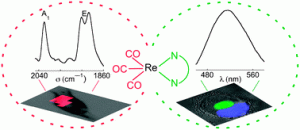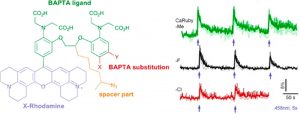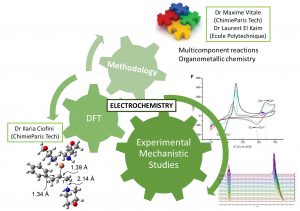2025
|
Locally activated semisynthetic fluorescent biosensors for imaging cellular biochemistry Article de journal Justine Coïs; Blaise Dumat Comptes Rendus. Chimie, 28 , p. 61-78, 2025, ISSN: 1878-1543. @article{Cois2024c,
title = {Locally activated semisynthetic fluorescent biosensors for imaging cellular biochemistry},
author = {Justine Co\"{i}s and Blaise Dumat},
url = {https://comptes-rendus.academie-sciences.fr/chimie/articles/10.5802/crchim.365/},
doi = {10.5802/crchim.365},
issn = {1878-1543},
year = {2025},
date = {2025-01-01},
journal = {Comptes Rendus. Chimie},
volume = {28},
pages = {61-78},
keywords = {},
pubstate = {published},
tppubtype = {article}
}
|
Kinetic Redox Shotgun Proteomics Reveals Specific Lipopolysaccharide Effects on Intestinal Epithelial Cells, Mitigated by a Mn Superoxide Dismutase Mimic Article de journal Martha Zoumpoulaki; Giovanni Chiappetta; Jean Bouvet; Namita-Raju John; Gabrielle Schanne; Pauline Gehan; Samuel Diebolt; Shakir Shakir; Elodie Quévrain; Emilie Mathieu; Sylvie Demignot; Philippe Seksik; Nicolas Delsuc; Joelle Vinh; Clotilde Policar Angewandte Chemie International Edition, n/a (n/a), p. e202422644, 2025. @article{https://doi.org/10.1002/anie.202422644,
title = {Kinetic Redox Shotgun Proteomics Reveals Specific Lipopolysaccharide Effects on Intestinal Epithelial Cells, Mitigated by a Mn Superoxide Dismutase Mimic},
author = {Martha Zoumpoulaki and Giovanni Chiappetta and Jean Bouvet and Namita-Raju John and Gabrielle Schanne and Pauline Gehan and Samuel Diebolt and Shakir Shakir and Elodie Qu\'{e}vrain and Emilie Mathieu and Sylvie Demignot and Philippe Seksik and Nicolas Delsuc and Joelle Vinh and Clotilde Policar},
url = {https://onlinelibrary.wiley.com/doi/abs/10.1002/anie.202422644},
doi = {https://doi.org/10.1002/anie.202422644},
year = {2025},
date = {2025-01-01},
journal = {Angewandte Chemie International Edition},
volume = {n/a},
number = {n/a},
pages = {e202422644},
abstract = {Abstract Overproduction of reactive oxygen species and antioxidant superoxide dismutases (SOD1, SOD2) dysregulation contribute to chronic inflammation such as generated in inflammatory bowel diseases (IBD). A kinetic redox shotgun proteomic strategy (OcSILAC for Oxidized cysteine Stable Isotope Labelling by Amino acids in Cell culture) was used to explore the lipopolysaccharide (LPS) effects including LPS-induced oxidation and inflammation cascades on a dedicated intestinal epithelial cell line (HT29-MD2) together with the potential mitigating role of a Mn-based SOD-mimic Mn1. While LPS induced transient oxidative damages at early times (15 min), cells incubated with Mn1 showed, in this time frame, a significantly reduced cysteine oxidation, highlighting Mn1 antioxidant properties. Over time, cysteine oxidation of LPS-treated cells was counteracted by an overexpression of antioxidant proteins (SOD1, NQO1) and a late (6 h) preponderant increase in SOD2 level. Mn1, when co-incubated with LPS, attenuated the level of most LPS-modified proteins, that is, proteins involved in the inflammatory response. Our results highlight Mn1 as a potentially effective antioxidant and anti-inflammatory agent to consider in the treatment of IBD, as well as a useful tool for exploring the interconnection between oxidative stress and inflammation.},
keywords = {},
pubstate = {published},
tppubtype = {article}
}
Abstract Overproduction of reactive oxygen species and antioxidant superoxide dismutases (SOD1, SOD2) dysregulation contribute to chronic inflammation such as generated in inflammatory bowel diseases (IBD). A kinetic redox shotgun proteomic strategy (OcSILAC for Oxidized cysteine Stable Isotope Labelling by Amino acids in Cell culture) was used to explore the lipopolysaccharide (LPS) effects including LPS-induced oxidation and inflammation cascades on a dedicated intestinal epithelial cell line (HT29-MD2) together with the potential mitigating role of a Mn-based SOD-mimic Mn1. While LPS induced transient oxidative damages at early times (15 min), cells incubated with Mn1 showed, in this time frame, a significantly reduced cysteine oxidation, highlighting Mn1 antioxidant properties. Over time, cysteine oxidation of LPS-treated cells was counteracted by an overexpression of antioxidant proteins (SOD1, NQO1) and a late (6 h) preponderant increase in SOD2 level. Mn1, when co-incubated with LPS, attenuated the level of most LPS-modified proteins, that is, proteins involved in the inflammatory response. Our results highlight Mn1 as a potentially effective antioxidant and anti-inflammatory agent to consider in the treatment of IBD, as well as a useful tool for exploring the interconnection between oxidative stress and inflammation. |
SOD mimics delivered to the gut using lactic acid bacteria mitigate the colitis symptoms in a mouse model of Inflammatory Bowel Diseases Article de journal Gabrielle Schanne; Amandine Vincent; Florian Chain; Pauline Ruffié; Célia Carbonne; Elodie Quévrain; Emilie Mathieu; Alice Balfourier; Luis G Bermúdez-Humarán; Philippe Langella; Sophie Thenet; Véronique Carrière; Nassim Hammoudi; Magali Svreck; Sylvie Demignot; Philippe Seksik; Clotilde Policar; Nicolas Delsuc Free Radical Research, p. 1–16, 2025, (PMID: 40079422). @article{Schanne13032025,
title = {SOD mimics delivered to the gut using lactic acid bacteria mitigate the colitis symptoms in a mouse model of Inflammatory Bowel Diseases},
author = {Gabrielle Schanne and Amandine Vincent and Florian Chain and Pauline Ruffi\'{e} and C\'{e}lia Carbonne and Elodie Qu\'{e}vrain and Emilie Mathieu and Alice Balfourier and Luis G Berm\'{u}dez-Humar\'{a}n and Philippe Langella and Sophie Thenet and V\'{e}ronique Carri\`{e}re and Nassim Hammoudi and Magali Svreck and Sylvie Demignot and Philippe Seksik and Clotilde Policar and Nicolas Delsuc},
url = {https://doi.org/10.1080/10715762.2025.2478121},
doi = {10.1080/10715762.2025.2478121},
year = {2025},
date = {2025-01-01},
journal = {Free Radical Research},
pages = {1--16},
publisher = {Taylor & Francis},
note = {PMID: 40079422},
keywords = {},
pubstate = {published},
tppubtype = {article}
}
|
Angle-dependent spin crossover properties in polymorphic iron (ii) complexes based on pyridine--triazole derivatives Article de journal Emmelyne Cuza; Nicolas Delsuc; Jer^ome Marrot; William Shepard; Clotilde Policar; Christian Serre; Antoine Tissot Dalton Transactions, 54 (15), p. 6274–6280, 2025. @article{cuza2025angle,
title = {Angle-dependent spin crossover properties in polymorphic iron (ii) complexes based on pyridine--triazole derivatives},
author = {Emmelyne Cuza and Nicolas Delsuc and Jer{^o}me Marrot and William Shepard and Clotilde Policar and Christian Serre and Antoine Tissot},
year = {2025},
date = {2025-01-01},
journal = {Dalton Transactions},
volume = {54},
number = {15},
pages = {6274--6280},
publisher = {Royal Society of Chemistry},
keywords = {},
pubstate = {published},
tppubtype = {article}
}
|
Harnessing Cyanine‐like Properties to Develop Bright Fluorogenic Probes Based on Viscosity‐Sensitive Molecular Rotors Article de journal Blaise Dumat; Carolina Chieffo Chemistry – A European Journal, 31 , p. e202404077, 2025, ISSN: 0947-6539. @article{Dumat2024,
title = {Harnessing Cyanine‐like Properties to Develop Bright Fluorogenic Probes Based on Viscosity‐Sensitive Molecular Rotors},
author = {Blaise Dumat and Carolina Chieffo},
url = {https://chemistry-europe.onlinelibrary.wiley.com/doi/10.1002/chem.202404077},
doi = {10.1002/chem.202404077},
issn = {0947-6539},
year = {2025},
date = {2025-01-01},
journal = {Chemistry \textendash A European Journal},
volume = {31},
pages = {e202404077},
abstract = { Dipolar fluorescent molecular rotors (FMRs) are environmentally‐sensitive fluorophores that can be used in bioimaging applications to sense local viscosity and polarity. Their sensitivity to viscosity can also be used for the fluorogenic labeling of biomolecules such as DNA or proteins. In particular, we have previously used FMRs to develop a series of tunable fluorogens targeting the self‐labeling protein tag Halotag for wash‐free protein imaging in live cells. Despite these very useful properties, FMRs typically display moderate molar absorption coefficients that limits their overall fluorescence brightness. Herein, we synthesized a series of three model hemicyanines based on a styrylindolenium scaffold and performed a detailed study of their photophysical properties in solvents with various polarity and viscosity. We show that with a strong julolidine electron‐donating group it is possible to combine intense cyanine‐like absorption with the high sensitivity to viscosity of FMRs. We use this property to develop a lysosomal pH sensor and two bright cell‐impermeant fluorogens targeting HaloTag for imaging membrane proteins. We believe that this bright fluorogenic scaffold based on a simple chemical structure can be used in the future to build up a variety of probes and sensors with efficient photophysical properties. },
keywords = {},
pubstate = {published},
tppubtype = {article}
}
<p>Dipolar fluorescent molecular rotors (FMRs) are environmentally‐sensitive fluorophores that can be used in bioimaging applications to sense local viscosity and polarity. Their sensitivity to viscosity can also be used for the fluorogenic labeling of biomolecules such as DNA or proteins. In particular, we have previously used FMRs to develop a series of tunable fluorogens targeting the self‐labeling protein tag Halotag for wash‐free protein imaging in live cells. Despite these very useful properties, FMRs typically display moderate molar absorption coefficients that limits their overall fluorescence brightness. Herein, we synthesized a series of three model hemicyanines based on a styrylindolenium scaffold and performed a detailed study of their photophysical properties in solvents with various polarity and viscosity. We show that with a strong julolidine electron‐donating group it is possible to combine intense cyanine‐like absorption with the high sensitivity to viscosity of FMRs. We use this property to develop a lysosomal pH sensor and two bright cell‐impermeant fluorogens targeting HaloTag for imaging membrane proteins. We believe that this bright fluorogenic scaffold based on a simple chemical structure can be used in the future to build up a variety of probes and sensors with efficient photophysical properties.</p> |
 Bioinorganic Chemistry
Bioinorganic Chemistry Bioorganic Chemistry
Bioorganic Chemistry
